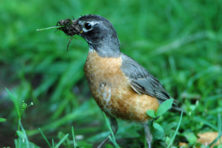Learn More About Lake Sturgeon, Our Missing Namesake Feb. 8, Speaker Will Discuss Dams’ Effects
- Share
- Tweet
- Pin
- Share

by COGGIN HEERINGA
Interpretive Naturalist, Crossroads at Big Creek, Inc.
Sturgeon will be the topic at Crossroads’ Fish Tales Lecture Series 7-9 pm Thursday, Feb. 8, when Dr. Patrick Forsythe presents, “Elevating Optimism of the Menominee River Through Successful Up and Downstream Passage of Lake Sturgeon.”
Because Crossroads is located in the City of Sturgeon Bay and our Cove Estuary Preserve skirts the Bay of Sturgeon Bay, we get a lot of questions about how the name came to be and if these huge fish still live here.
According to Ann Jinkins and Maggie Weir in their book “Sturgeon Bay,” French explorer, Fr. Claude Allouez, who wintered with the Pottawatomie in 1676, was the first to write “La Portage des Eturgeons,” apparently referring to the plentiful sturgeon in the bay.
In the book, Brief History of Door County, (and it is brief, as it was written in 1881 and there was not a great deal of written history back then), Chas. I Martin wrote, “Sturgeon, the largest fish caught in this water, are dressed and generally cut into large strips, and smoked.”
Martin continued, “The sturgeon is a peculiar fish, looking something like a creek ‘sucker,’ has dark skin; is as destitute of scales as a man’s face; varies in length from two to nine feet – the average being about four or five feet – and there is not a bone in its body. What is called the back-bone is a large grizzle that can be easily cut with a knife.
“The sturgeon often grows to great weight, and it is a powerful fish in the water – its flesh is a beautiful bright yellowing tint, and if properly cooked, is grand eating beyond description.”
Later in his book, in describing how the name “Otumba” was changed to “Sturgeon Bay,” Martin wrote, “The name of that arm or bay over … Green Bay, now so well known as ‘Sturgeon Bay,’ originated among the Menominee Indians. They so named it because of its outline being about the shape of the finny tribe being so plentiful in these waters.”
This shows that as of 1881 in Door County, sturgeon were plentiful and sought after by the 700 families living on the peninsula at that time. So what happened?
Liz Carey, in an article in the Daily Yonder, quoted our speaker, Dr. Forsythe as saying, “In recent decades, the sturgeon population was down to about 1 to 2% of its historic abundance.
“Some of the decline was due to overfishing,” he explained, “but most was due to a dam system. Built in the early 1900s, the five dams along the Menominee River were first put in to help logging operations along the river. As time passed, the dams were converted to hydro-electric dams to help fuel the area with electricity.”
Six years ago, during our inaugural Fish Tales Lecture Series, Rob Elliott, fish biologist for the U.S. Fish and Wildlife Service, presented the lecture, “All About Lake Sturgeon – Recovery Efforts in Green Bay and the Great Lakes.” In it, he described a fish elevator, a project on the Menominee River that could lift sturgeon above the first dam and transport them beyond the second dam.
The Feb. 8 lecture titled, “Elevating Optimism of the Menominee River,” is a play on words. Dr. Patrick Forsythe, University of Wisconsin-Green Bay, will discuss the fish elevator project on the Menominee River and discuss genetic research on sturgeon reproduction and dispersal, and share his optimism that the sturgeon population in Lake Michigan might increase.Learn more Feb. 8 at Crossroads, 2041 Michigan St. in Sturgeon Bay, or participate via ZOOM or Facebook Live at doorcountylibrary.org/event.html.




